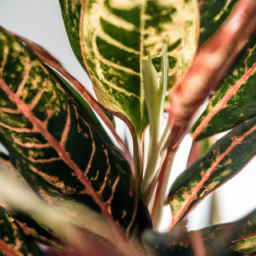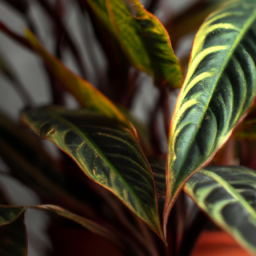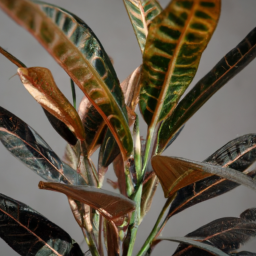
Are you looking to add a pop of color and a touch of tropical flair to your indoor space? Look no further than Crotons indoor plants! These vibrant and versatile plants are perfect for bringing a bit of the outdoors inside, whether you have a green thumb or are new to plant care. Crotons indoor plants are known for their colorful foliage and striking patterns, making them a popular choice for adding visual interest to any room. In this blog post, we’ll explore everything you need to know about caring for Crotons indoor, from lighting and watering requirements to common pests and diseases. So, grab your gardening gloves and let’s dive into the wonderful world of Crotons indoor plants!
Benefits of Growing Crotons Indoors
Introduction
Crotons are vibrant and colorful plants that can add a pop of color to any indoor space. They are relatively easy to care for and can thrive in a variety of conditions. In this guide, we will explore the benefits of growing crotons indoors and provide you with tips on how to care for these beautiful plants.
Health Benefits
One of the main benefits of growing crotons indoors is the health benefits they provide. Crotons are known for their air-purifying properties, which can help improve the air quality in your home. These plants can remove toxins such as formaldehyde, benzene, and trichloroethylene from the air, making it cleaner and healthier to breathe.
In addition to their air-purifying abilities, crotons can also help reduce stress and improve mental well-being. Studies have shown that being around plants can help lower blood pressure, reduce anxiety, and increase feelings of happiness and relaxation. Having crotons in your home can create a calming and peaceful environment that promotes overall wellness.
Furthermore, caring for plants such as crotons can provide a sense of purpose and accomplishment, which can boost self-esteem and mental health. Taking the time to nurture and watch your crotons grow can be a rewarding and therapeutic experience that can improve your overall quality of life.
Overall, growing crotons indoors can have a positive impact on both your physical and mental health, making them a great addition to any indoor space.
Aesthetic Benefits
Another major benefit of growing crotons indoors is the aesthetic appeal they bring to your home. Crotons are known for their vibrant and colorful foliage, which can brighten up any room and add a touch of tropical flair. With their unique leaf shapes and patterns, crotons can serve as eye-catching focal points in your home decor.
Additionally, crotons are versatile plants that can be grown in a variety of containers and arrangements, making them easy to incorporate into any design style. Whether you prefer a minimalist, modern look or a cozy, bohemian vibe, crotons can complement your decor and enhance the overall aesthetic of your space.
Furthermore, crotons are low-maintenance plants that require minimal care and attention, making them perfect for busy individuals or those with a black thumb. With the right lighting, watering, and pruning, crotons can thrive indoors and continue to provide beauty and color to your home year-round.
In conclusion, growing crotons indoors can enhance the aesthetic appeal of your home and bring a touch of nature indoors, making them a valuable addition to any indoor space.

Best Indoor Care Tips for Crotons
As an expert in caring for indoor crotons, I am excited to share with you some of the best tips to ensure your crotons thrive in your home environment. Crotons are beautiful and vibrant plants that can add a pop of color to any indoor space. With the right care, these plants can flourish and bring joy to your home for years to come.
Lighting
One of the most important factors in caring for indoor crotons is providing them with the right amount of light. Crotons thrive in bright, indirect light. Place your croton plant near a window where it can receive plenty of sunlight, but be sure to avoid direct sunlight, as this can scorch the leaves. If you notice your croton’s leaves starting to fade or lose their vibrant colors, it may be a sign that it is not getting enough light.
During the winter months when the days are shorter, you may need to supplement your croton’s light with a grow light to ensure it is getting enough light to thrive. Be sure to rotate your plant every few weeks to ensure all sides receive adequate light and prevent it from leaning towards the light source.
Overall, providing your croton with the right amount of light is essential for its growth and vibrancy. Pay attention to any changes in its leaves to determine if it is receiving enough light.
Watering
Proper watering is another key aspect of caring for indoor crotons. These plants prefer consistently moist soil, but they do not like to sit in water. Allow the top inch of soil to dry out between waterings, and then water thoroughly until water drains out of the bottom of the pot. Be sure to empty the saucer under the pot to prevent the roots from sitting in water.
During the growing season in spring and summer, you may need to water your croton more frequently, as it will be actively growing. In the winter months, when growth slows down, you can reduce the frequency of watering. Be sure to monitor the moisture level of the soil regularly and adjust your watering schedule as needed.
Overwatering can lead to root rot, while underwatering can cause the leaves to wilt and drop. Finding the right balance in watering is crucial for the health of your indoor croton.
Humidity
Crotons thrive in high humidity environments, so it is important to provide them with the right level of moisture in the air. If your home has dry air, especially in the winter months when the heat is running, consider using a humidifier to increase the humidity around your croton plant.
You can also create a humid environment for your croton by placing a tray filled with water and pebbles near the plant. As the water evaporates, it will increase the humidity around the plant. Misting the leaves of your croton with water can also help increase humidity and keep the plant healthy.
Be sure to monitor the humidity level around your croton and make adjustments as needed to ensure it is thriving in its environment. With the right amount of humidity, your indoor croton will continue to display its vibrant colors and lush foliage.

Top Varieties of Crotons for Indoor Spaces
Introduction
Crotons are popular houseplants known for their vibrant and colorful foliage. They are relatively easy to care for and can add a pop of color to any indoor space. There are many different varieties of crotons to choose from, each with its own unique characteristics and colors. In this article, we will explore some of the top varieties of crotons that are well-suited for indoor environments.
Varieties
One popular variety of croton is the ‘Petra’ croton. This variety features bright red, orange, and yellow leaves that are sure to grab attention. ‘Petra’ crotons are known for their compact growth habit, making them ideal for small indoor spaces. They thrive in bright, indirect light and prefer to be kept in consistently moist soil.
Another popular variety is the ‘Mammy’ croton. This variety has striking dark green leaves with bright red veins running through them. ‘Mammy’ crotons can grow quite large, making them a great choice for filling empty corners or large spaces in your home. They prefer bright, indirect light and should be watered when the top inch of soil feels dry.
One more variety to consider is the ‘Gold Dust’ croton. This variety has glossy green leaves speckled with yellow spots, resembling gold dust. ‘Gold Dust’ crotons are relatively low-maintenance and can adapt to a variety of light conditions, although they prefer bright, indirect light. They should be watered when the top inch of soil feels dry to the touch.
In addition to these varieties, there are many other types of crotons to choose from, each with its own unique colors and patterns. When selecting a croton for your indoor space, consider the amount of light it will receive and the size of the plant at maturity.
Care Tips
When caring for crotons indoors, it is important to provide them with the right growing conditions to ensure they thrive. Crotons prefer bright, indirect light, so be sure to place them near a window where they will receive plenty of sunlight. Avoid placing them in direct sunlight, as this can cause their leaves to burn.
In terms of watering, crotons like to be kept consistently moist but not waterlogged. Water your croton when the top inch of soil feels dry to the touch, and be sure to provide good drainage to prevent root rot. You can also increase humidity around your croton by misting it regularly or placing a humidifier nearby.
Finally, be sure to fertilize your croton regularly to promote healthy growth and vibrant foliage. Use a balanced fertilizer formulated for houseplants and follow the instructions on the packaging. With proper care and attention, your croton will reward you with its beautiful colors and patterns for years to come.
In conclusion, crotons are a fantastic choice for adding color and interest to your indoor space. With their wide range of varieties and relatively easy care requirements, there is sure to be a croton that suits your style and space. Consider adding one of these top varieties to your indoor plant collection today!
In a Nutshell
Crotons are beautiful and vibrant plants that can add a pop of color to any indoor space. These tropical plants are known for their colorful, glossy leaves that come in shades of red, orange, yellow, and green. They are relatively easy to care for and can thrive indoors with the right conditions.
To keep your croton plant healthy and happy, make sure to place it in a well-lit area with indirect sunlight. Water your croton when the top inch of soil feels dry, and be sure not to overwater as this can lead to root rot. Crotons also benefit from regular misting to increase humidity levels. With a little bit of care and attention, your croton plant can brighten up your home and bring a touch of the tropics indoors.
Let me leave you with some FAQs:
Q1. Can crotons be grown indoors?
Crotons can definitely be grown indoors as long as they receive enough sunlight, water, and proper care. They are popular houseplants known for their colorful and vibrant foliage.
Q2. How much sunlight do crotons need indoors?
Crotons thrive in bright, indirect light. They should be placed near a window where they can receive plenty of sunlight throughout the day. However, be cautious of direct sunlight as it can scorch their leaves.
Q3. How often should I water my indoor croton plant?
Water your indoor croton plant when the top inch of soil feels dry to the touch. It’s important not to overwater them as they are susceptible to root rot. Allow the soil to dry out slightly between waterings.
Q4. What is the best temperature for indoor crotons?
Indoor crotons prefer temperatures between 60-85°F (15-29°C). They can tolerate slightly cooler temperatures, but it’s best to avoid exposing them to drafts or sudden temperature changes.
Q5. How can I maintain the vibrant colors of my indoor croton plant?
To maintain the vibrant colors of your indoor croton plant, make sure it receives enough sunlight and proper care. Regularly dust the leaves to allow maximum light absorption. You can also mist the leaves occasionally to increase humidity and keep them looking their best.
Dr. Olivia Green is a botanist with over two decades of experience in indoor plant cultivation. She holds a Ph.D. in Plant Biology and has dedicated her career to researching plant behavior in controlled environments. Dr. Green is passionate about helping plant enthusiasts master the art of indoor gardening through her extensive knowledge and practical insights.


